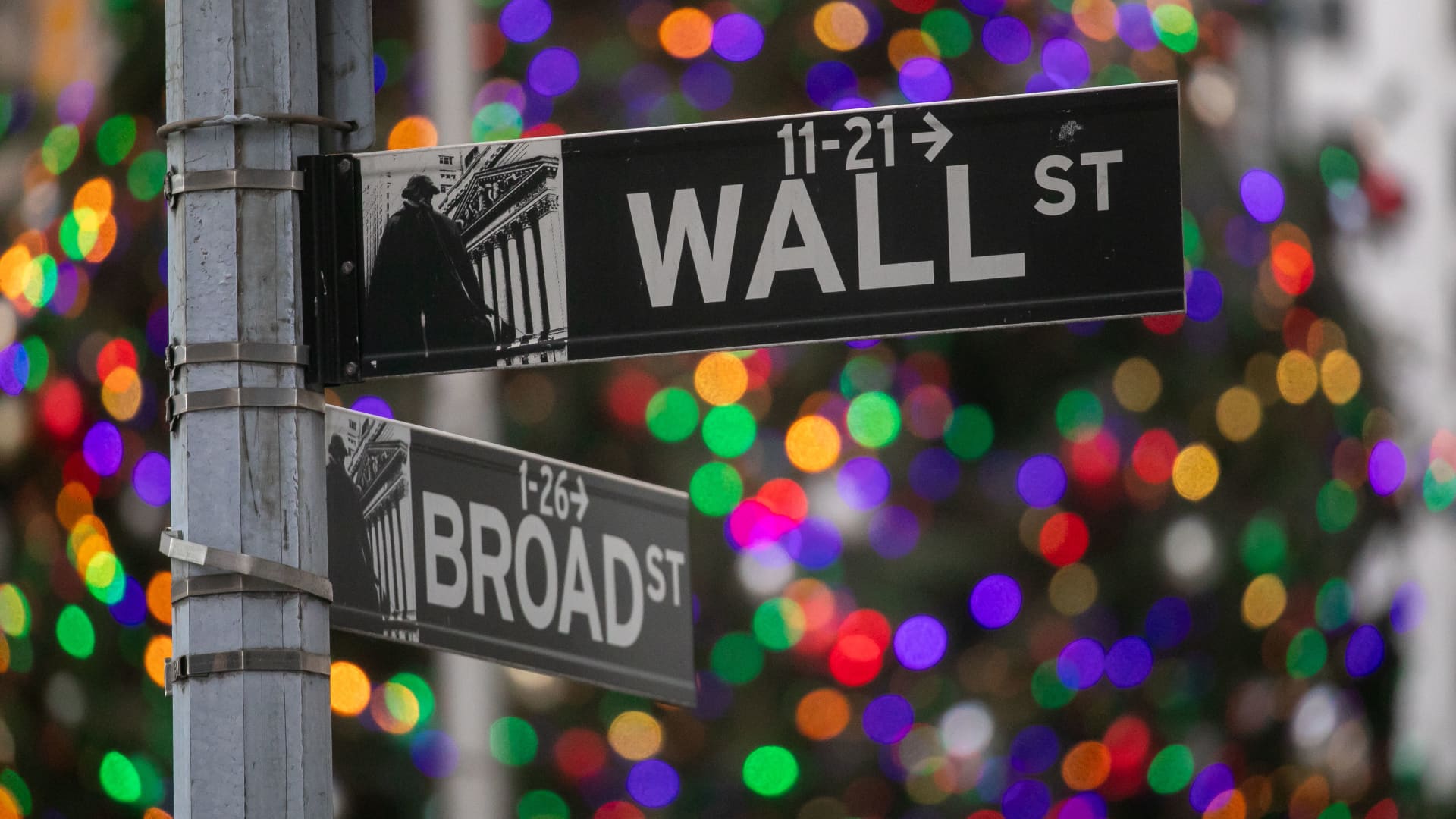You may be interested
- Buying SpaceX Stock Has Never Been Easier, But Beware The Risks
- Want $300 in Super-Safe Dividend Income in 2025? Invest $3,730 Into the Following 3 Ultra-High-Yield Stocks.
- AGNC Investment (AGNC) Flat As Market Gains: What You Should Know
- Biden boosted investment in the electric grid. What will Trump do?
- Emerging markets face heavy weekly fund outflows
Making investment decisions on speculation or quirky seasonal trends is not how we manage the CNBC Investing Club portfolio. Jim Cramer ran a hedge fund where holding times for positions could be as quick as a matter of minutes — not weeks, months, or years as we aim for at the Club. In last Sunday’s column , Jim provided some thoughts on the frothy state of the market and why we don’t own names such as Tesla or Palantir in the portfolio. “I don’t see any reason to buy Tesla or Palantir except for the fact that I think they are going higher,” he said. “That’s a good hedge reason to buy. But that’s not a good portfolio management reason to buy. The Club invests in stocks based on fundamentals, not speculation.” That’s not to say Tesla and Palantir aren’t good companies — if anything they’re great. It’s not a criticism of their management abilities either — both companies are run by what many on Wall Street would consider to be genius-level founders in Elon Musk and Alex Karp. Jim’s reasoning is, however, about valuation. Neither of these companies is anything close to “cheap” — and if you think they are fairly valued, then you have to believe that their growth will continue, at break-neck speeds, beyond the foreseeable future. That may be the case, but it also means that to own them, you have to be willing to speculate a good deal — to put faith in what may come well beyond what we can reasonably expect to see in the near term, not what the metrics are forecasting now or for the near-term. While each investor needs to consider their own risk appetite for taking big swings, Jim, Jeff Marks , director or portfolio analysis, and I manage a Charitable Trust of 30-somethings stocks. It’s the portfolio Jim set up decades ago when he left Wall Street to keep skin in the game without conflict and to teach people how to invest with real money and real trades. Our self-instituted mandate for the Trust, which is the portfolio we use at the Club, is to base investment decisions on fundamentals, which severely limits our ability to speculate on names like Tesla or Palantir. That’s true not only for stock selection but also when it comes to navigating the market’s various seasonal patterns, including year-end and new-year seasonal trends. Every December, the Santa Claus rally, which measures the last five trading days in a year and the first two trading days of the next year, gets a lot of attention. We say “Santa Claus rally” because that stretch tends to be bullish. That then feeds the idea of how January goes, goes the year, or the January effect as it is known. The investors who pay attention to seasonality may well have historical data to “support” their case. The problem is — the same way that bidding up Tesla and Palantir for no other reason that they could be up tomorrow — those highlighting these monthly patterns can’t tell you why they’re happening, only that they have tended to happen in the past. There’s no real look at what happened in each of those years, only that it happened or didn’t happen. By the way, there was no Santa rally this time around. The S & P 500 is just about flat in the first five trading days of 2025 with the bulk of January to go. So, the jury is still out on whether the January effect will be viewed as positive for the rest of the year or negative. To play the seasonality or speculation game successfully, you have to market time — picking perfect times to sell and perfect times to buy — which Jim has said over and over again is impossible to do consistently enough to make it worth it. Market timing is largely based on technical patterns and headlines — basically day trading. If you want to go down that road, keep in mind that you are against some of the wealthiest, most sophisticated, well-connected people on Wall Street (or anywhere else for that matter) — not to mention the high-frequency trading algorithms. Unlike the practice of long-term investing — the discipline that rules the Club, where we analyze companies and management teams — day traders ride momentum, analyze chart patterns, or play seasonal market patterns, which means betting on your ability to navigate the markets in real-time 24/7, sell shares to the greater fool, and be faster than everyone else, with nothing more to go on that the knowledge that it’s happened before. The “analysis” gets even more astrology-like when we start using one seasonal trend to predict another. Using the example above, some folks will argue they can tell you what January will look like based on the Santa Claus rally — and that, in turn, will determine the year. So, how the way the market trades in a seven-session period when most people are on vacation is supposed to tell you how to position for the next 12 months? That’s not very rigorous if you ask us. What does the pattern predict if the S & P 500 fell 0.53% during the entirety of this latest Santa Claus rally period, but jumped 1.26% on the final day — Friday, Jan. 3? After Monday’s modest gain, Tuesday’s decline, and Wednesday’s small bounce, the S & P 500 was slightly in the green year to date. But with the market closed Thursday for a national day of mourning to honor former President Jimmy Carter and Friday’s slump on stronger jobs data and a spike in bond yields, how can you predict the year? January has yet to have a full five days in a row of stock trading. .SPX mountain 2024-12-24 S & P 500 performance since Dec. 24 Is there something in that data that should tell us how to position our portfolio? How much weight should we give that against the fact that Donald Trump’s presidential inauguration is a little over a week away on Jan. 20, or the idea that when Trump re-enters the White House, his Republican party will control both the House and Senate? How do we look at the price action of a two-week period against what we just saw and heard from Jensen Huang, CEO of Club name Nvidia , at CES earlier this week? If you ask us, put a ton of weight on the fundamental drivers of the economy, stock market, and individual companies, and little to none when it comes to reading seasonal patterns as if they’re stars in the sky. The same can be said of Tesla and Palantir. What do you do now that the froth is coming out of the market? Palantir, for example, has seen a nasty three-session losing streak this week following last Friday’s more than 6% jump. Palantir soared 340% in 2024. You were playing momentum and the momentum is gone, hopefully, you made it out with a profit. You could, of course, be looking to double down but then why here? What makes Palantir more attractive at $70 per share than it was at $80. Sure, it’s $10 cheaper but with analysts estimating earnings of 47 cents per share in 2025, it’s still trading at nearly 150 times earnings, not exactly a bargain. Tesla isn’t much cheaper at about 120 times 2025 earnings estimates. It’s down for 2025 after soaring more than 60%. The bulk of those gains happened after Trump, whom Musk supported, won the November presidential election. That’s the problem when you trade on something other than fundamentals. What do you do when the stock suddenly doesn’t go up one day or for a few days? What do you do when the seasonal pattern isn’t quite clear or simply doesn’t pan out? If that’s what you were trading on, you probably have to bail, or worse end up stuck like a deer in the headlights. By focusing on the fundamentals, however, you have something clear-cut to key off of that tells you if the price action makes sense, or if it’s something to take advantage of. In the end, while we acknowledge that there are seasonal patterns in the market – just as we acknowledge that Tesla and Palantir have been “up” stocks and that “up” stocks will always be out there, we must also be honest that making sweeping adjustments to our exposure based on these trends and momentum is not the game we’re playing. With that in mind, our view is that investors will always be better served by studying the underlying fundamentals of companies to determine if a business is being undervalued, fairly valued, or overvalued, in the stock market — and then, acting accordingly. (Jim Cramer’s Charitable Trust is long NVDA. See here for a full list of the stocks.) As a subscriber to the CNBC Investing Club with Jim Cramer, you will receive a trade alert before Jim makes a trade. Jim waits 45 minutes after sending a trade alert before buying or selling a stock in his charitable trust’s portfolio. If Jim has talked about a stock on CNBC TV, he waits 72 hours after issuing the trade alert before executing the trade. THE ABOVE INVESTING CLUB INFORMATION IS SUBJECT TO OUR TERMS AND CONDITIONS AND PRIVACY POLICY , TOGETHER WITH OUR DISCLAIMER . NO FIDUCIARY OBLIGATION OR DUTY EXISTS, OR IS CREATED, BY VIRTUE OF YOUR RECEIPT OF ANY INFORMATION PROVIDED IN CONNECTION WITH THE INVESTING CLUB. NO SPECIFIC OUTCOME OR PROFIT IS GUARANTEED.
A Wall Street sign in front of the New York Stock Exchange (NYSE) in New York, US.
You are viewing: Why investing based on pure speculation or arbitrary seasonal patterns is reckless
Bloomberg | Bloomberg | Getty Images
Making investment decisions on speculation or quirky seasonal trends is not how we manage the CNBC Investing Club portfolio. Jim Cramer ran a hedge fund where holding times for positions could be as quick as a matter of minutes — not weeks, months, or years as we aim for at the Club.
Source: https://magnacumlaude.store
Category: News

